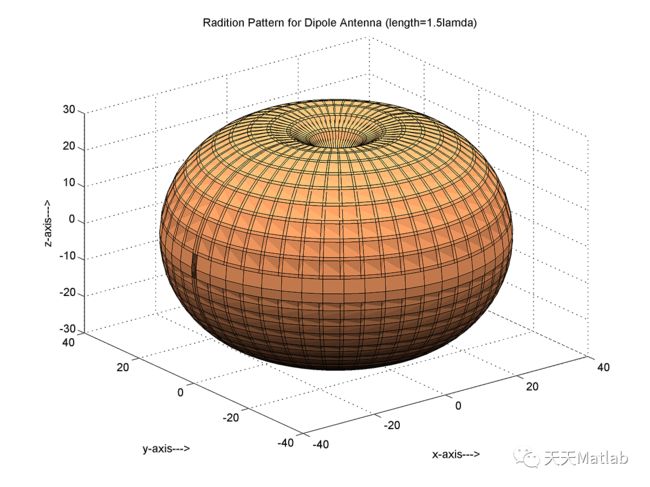基于Matlab模拟3维偶极子天线
✅作者简介:热爱科研的Matlab仿真开发者,修心和技术同步精进,matlab项目合作可私信。
个人主页:Matlab科研工作室
个人信条:格物致知。
更多Matlab仿真内容点击
智能优化算法 神经网络预测 雷达通信 无线传感器
信号处理 图像处理 路径规划 元胞自动机 无人机 电力系统
⛄ 内容介绍
研究了直线天线的两种简单分析模型:无穷小偶极子和有限长偶极子.建立了偶极子辐射强度和方向性系数数学模型.应用MATLAB对其性能进行了仿真分析.通过仿真分析比较,得出了和实际结果相符的结论,从而为天线的研究提供了有价值的基础理论.
⛄ 完整代码
% Redistribution and use in source and binary forms, with or without
% modification, are permitted provided that the following conditions are
% met:
%
% * Redistributions of source code must retain the above copyright
% notice, this list of conditions and the following disclaimer.
% * Redistributions in binary form must reproduce the above copyright
% notice, this list of conditions and the following disclaimer in
% the documentation and/or other materials provided with the distribution
%
% THIS SOFTWARE IS PROVIDED BY THE COPYRIGHT HOLDERS AND CONTRIBUTORS "AS IS"
% AND ANY EXPRESS OR IMPLIED WARRANTIES, INCLUDING, BUT NOT LIMITED TO, THE
% IMPLIED WARRANTIES OF MERCHANTABILITY AND FITNESS FOR A PARTICULAR PURPOSE
% ARE DISCLAIMED. IN NO EVENT SHALL THE COPYRIGHT OWNER OR CONTRIBUTORS BE
% LIABLE FOR ANY DIRECT, INDIRECT, INCIDENTAL, SPECIAL, EXEMPLARY, OR
% CONSEQUENTIAL DAMAGES (INCLUDING, BUT NOT LIMITED TO, PROCUREMENT OF
% SUBSTITUTE GOODS OR SERVICES; LOSS OF USE, DATA, OR PROFITS; OR BUSINESS
% INTERRUPTION) HOWEVER CAUSED AND ON ANY THEORY OF LIABILITY, WHETHER IN
% CONTRACT, STRICT LIABILITY, OR TORT (INCLUDING NEGLIGENCE OR OTHERWISE)
% ARISING IN ANY WAY OUT OF THE USE OF THIS SOFTWARE, EVEN IF ADVISED OF THE
% POSSIBILITY OF SUCH DAMAGE.
%**************************************************************************
% Name: RadPattern3D
% Author: Arslan Shahid
% Date: March 15, 2010
% Description: 3-D Radiation Pattern of Dipole Antenna
% Reference Constantine A.Balanis, Antenna Theory Analysis And
% Design , 3rd Edition, page 173, eq. 4-64
%**************************************************************************
%Usage:
%This program plots 3-D radiation Pattern of a Dipole Antenna
%All the parameters are entered in the M-File
clear all
%Defining variables in spherical coordinates
theta=[0:0.12:2*pi];%theta vector
phi=[0:0.12:2*pi];%phi vector
l_lamda1=1/100;% length of antenna in terms of wavelengths
I0=1;% max current in antenna structure
n=120*pi;%eta
% evaluating radiation intensity(U)
U1=( n*( I0^2 )*( ( cos(l_lamda1*cos(theta-(pi/2))/2) - cos(l_lamda1/2) )./ sin(theta-(pi/2)) ).^2 )/(8*(pi)^2);
%converting to dB scale
U1_1=10*log10(U1);
%normalizing in order to make U vector positive
min1=min(U1_1);
U=U1_1-min1;
% expanding theta to span entire space
U(1,1)=0;
for n=1:length(phi)
theta(n,:)=theta(1,:);
end
% expanding phi to span entire space
phi=phi';
for m=1:length(phi)
phi(:,m)=phi(:,1);
end
% expanding U to span entire space
for k=1:length(U)
U(k,:)=U(1,:);
end
% converting to spherical coordinates
[x,y,z]=sph2cart(phi,theta,U);
%plotting routine
surf(x,y,z)
colormap(copper)
title('Radition Pattern for Dipole Antenna (length=1.5lamda)')
xlabel('x-axis--->')
ylabel('y-axis--->')
zlabel('z-axis--->')
⛄ 运行结果
⛄ 参考文献
[1]张清泉等. "基于MATLAB的偶极子辐射性能仿真分析." 仪器仪表与分析监测 3(2011):3.
⛄ 完整代码
❤️部分理论引用网络文献,若有侵权联系博主删除
❤️ 关注我领取海量matlab电子书和数学建模资料
